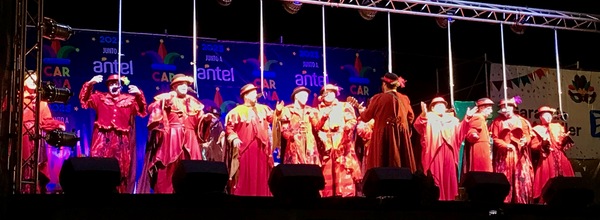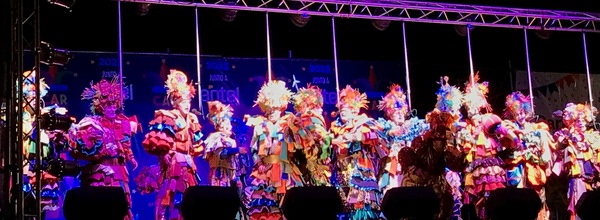So goes the Murga
In Uruguay there is a season each year during southern hemisphere summer called “Carnaval.” It runs from the end of January until the beginning of March.

In Carnaval there are several events. The broadest of these is nightly stage performances in Teatro del Verano and in Tablados around the capital city of Montevideo and the rest of the country. Teatro del Verano is an open air amphitheater with band shell located in Montevideo. Tablados are open air stages, mostly in parks, with informal, lawn chair seating.
There are five types of stage performances. The most popular of them is called the “Murga”.
The Murga is a choral work with brief interludes of dialog. The chorus of about a dozen members, plus a choral director and a rhythm section of three make-up the complete complement of performers. The rhythm section has symbols, bass drum, and snare drum. All of the performers have painted faces with a white base and brightly colored designs, eye makeup, and glitter.
At the beginning, the chorus sings an extended greeting, celebration, and invocation of Carnaval. They do so in colorful, full length dresses with broad, built-up shoulders, high collars, and elaborate, generally tall and colorful hats.
The invocation of Carnaval is more than an invocation of a period or event. It is an invocation of a special license to discourse freely and openly around social conditions and situations in a way that might otherwise cause social ostracism or censure. I’m reminded of the role of the court jester in the courts of Europe during the middle ages. The jester was the only member of court who could openly make fun of the royals. In return, they traded to be suffered as fools.
After the invocation, the performers change costume. One or a few performers will present a monologue or exchange dialog during the change.
What follows is a series of pieces designed to poke fun at differing aspects of the society, community, leadership, and government of Uruguay. The best of them do so in a way that emphasises what we would hope to be while undermining our high opinion of ourselves, and the hypocrisy of how we behave in truth.
This year 2023 winners of the competition among twenty-one murga groups was Asaltantes con Patente (asailants with license). You can view their winning performance on YouTube. If you’re not following the Spanish, enjoy the spectacle.
They touch on topics such as class and poverty, education, the problem of truth in communications, government scandals. A recurrent topic this year was the current government’s attempts at spending reduction in social services, especially in education. There was a scandal involving a network of government employees, including the head of security for the President, selling officially issued Uruguayan passports to Russian nationals.
The murga generally ends on an upbeat, something inspirational. For example, Asalantes con Patente urges people to be open with friends and family about their feelings, concerns and troubles. They go on to urge parents to listen thoughtfully to their children.

At the end, the dress costumes reappear. The chorus celebrates the freedom and license of Carnaval, underscores the inspirational message, and then bids farewell. The chorus repeats their song of farewell as they leave the stage, pass through the audience, and exit the performance space into the world at large.
So goes the murga, as they say. That’s life. Carnaval.